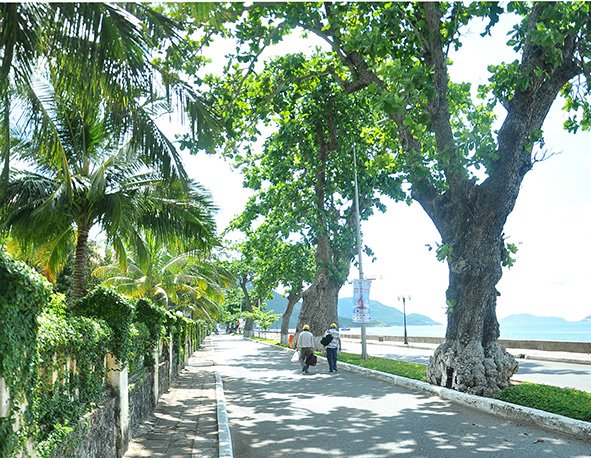Roasted Terminalia catappa fruit seeds on Con Dao
 |
| Terminalia catappa on Con Dao Island - PHOTO: VAN TUAN |
The old Terminalia catappa growing all over Con Dao Island are recognized as relic trees. According to archives at Con Dao Museum, this tree is considered a historical witness in addition to providing the deep shade. In the past, Terminalia catappa leaves were used to communicate by prisoners. They also hid letters, confidential documents and even foodstuffs under the trees.
On November 26 Con Dao islanders collect Terminalia catappa fruit and turn it into a tasty specialty. Harvest usually takes place between March and September. The fruit is dried and the seed within the fruit is removed. Then the seed is cleaned and roasted with salt or sugar.
The roasted seed costs from VND200,000 to VND400,000 per kilogram. In addition to conventional packaging, local folk also vacuum-pack the seed for longer storage.
It would be a great regret if one does not try eating roasted Terminalia catappa fruit seeds on Con Dao Island.
The 21st International Charity Bazaar to open in town
The 21st Annual International Charity Bazaar scheduled for 9:30 a.m. this Saturday will sell a wide range of goods and foods from all over the world with proceeds to benefit the disadvantaged in the community.
Entrance fee to this year’s event costs VND100,000 for adults, and children aged under 10 accompanied by an adult can enter free of charge.
In addition, visitors can buy tickets at VND50,000 to participate in the lucky draw program.
The organizers expect this year’s bazaar to attract crowds of Vietnamese and expatriates alike, and should exceed the number of 2,100 who attended last year’s event.
The charity bazaar organized by the Consular Club comprising members from 20 consular missions and trade representatives in HCMC will take place at the White Palace Convention Center at 194 Hoang Van Thu St. in the city’s Phu Nhuan District.
For more information, contact charitybazaarhcmc2014@gmail.com or visit www.consularclub.com.
UNESCO reviews Vietnam’s Vi-Giam folk music
The UNESCO Inter-governmental Committee for the Safeguarding of the Intangible Cultural Heritage’s 9th session kicking off in Paris on Monday is scheduled to review 46 nominations for UNESCO’s recognition as the world intangible cultural heritages of humanity including Vietnam’s Vi-Giam folk music.
The committee will examine national reports on the current status of those on the List of Intangible Cultural Heritage in Need of Urgent Safeguarding and reports on the use of international assistance from the Intangible Cultural Heritage Fund.
Vi-Giam folk music is very popular in many villages in the central provinces of Nghe An and Ha Tinh. This type of music reflects the work, cultural life and feelings of the residents in the provinces.
The two provinces have 51 singing clubs with over 800 vocalists, many of whom are actively preserving the traditional folk music.
Vietnam now has seven types of intangible heritage recognized by the UNESCO as world intangible heritages, namely Hue’s royal court music, Gong space culture in the Central Highlands, love duet singing in the northern province of Bac Ninh, the Giong festival, Ca Tru ceremonial singing, Xoan singing, Don Ca Tai Tu music, and Hung King’s worship.
The UNESCO Inter-governmental Committee for the Safeguarding of the Intangible Cultural Heritage’s 9th session will end this Friday.
What the stars mean:
★ Poor ★ ★ Promising ★★★ Good ★★★★ Very good ★★★★★ Exceptional
Latest News
More News
- The destinations powering Vietnam’s festive season travel demand (December 04, 2025 | 18:33)
- Vietnam named among the world’s most exciting winter destinations (December 04, 2025 | 15:10)
- Phu Tho emerges as northern Vietnam’s new tourism hub (December 01, 2025 | 17:00)
- Vietjet completes Airbus A320/A321 updates ahead of deadline (December 01, 2025 | 09:49)
- Vietjet resumes Con Dao flights from early December (November 28, 2025 | 15:24)
- Free tickets, Lunar New Year promotions on offer at Vietjet Mega Livestream (November 26, 2025 | 15:32)
- Scandinavian Airlines and Vietnam Airlines broaden agreement with new routes (November 25, 2025 | 17:04)
- Halong Cruise Port welcomes over 3,100 international visitors (November 12, 2025 | 18:06)
- Vietnam.travel climbs to second place in Southeast Asia website rankings (November 12, 2025 | 18:01)
- Cat Ba named among Southeast Asia’s top island adventures (November 11, 2025 | 18:09)

















 Mobile Version
Mobile Version